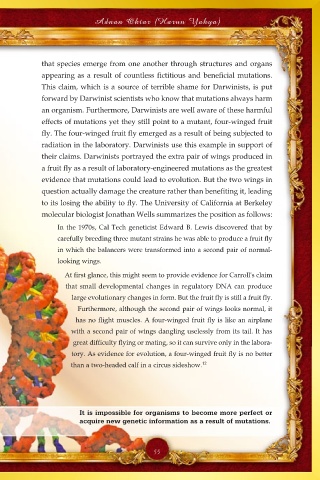Page 57 - Death of the Darwinist Dajjal System
P. 57
Adnan Oktar (Harun Yahya)
that species emerge from one another through structures and organs
appearing as a result of countless fictitious and beneficial mutations.
This claim, which is a source of terrible shame for Darwinists, is put
forward by Darwinist scientists who know that mutations always harm
an organism. Furthermore, Darwinists are well aware of these harmful
effects of mutations yet they still point to a mutant, four-winged fruit
fly. The four-winged fruit fly emerged as a result of being subjected to
radiation in the laboratory. Darwinists use this example in support of
their claims. Darwinists portrayed the extra pair of wings produced in
a fruit fly as a result of laboratory-engineered mutations as the greatest
evidence that mutations could lead to evolution. But the two wings in
question actually damage the creature rather than benefiting it, leading
to its losing the ability to fly. The University of California at Berkeley
molecular biologist Jonathan Wells summarizes the position as follows:
In the 1970s, Cal Tech geneticist Edward B. Lewis discovered that by
carefully breeding three mutant strains he was able to produce a fruit fly
in which the balancers were transformed into a second pair of normal-
looking wings.
At first glance, this might seem to provide evidence for Carroll's claim
that small developmental changes in regulatory DNA can produce
large evolutionary changes in form. But the fruit fly is still a fruit fly.
Furthermore, although the second pair of wings looks normal, it
has no flight muscles. A four-winged fruit fly is like an airplane
with a second pair of wings dangling uselessly from its tail. It has
great difficulty flying or mating, so it can survive only in the labora-
tory. As evidence for evolution, a four-winged fruit fly is no better
than a two-headed calf in a circus sideshow. 12
It is impossible for organisms to become more perfect or
acquire new genetic information as a result of mutations.
55

